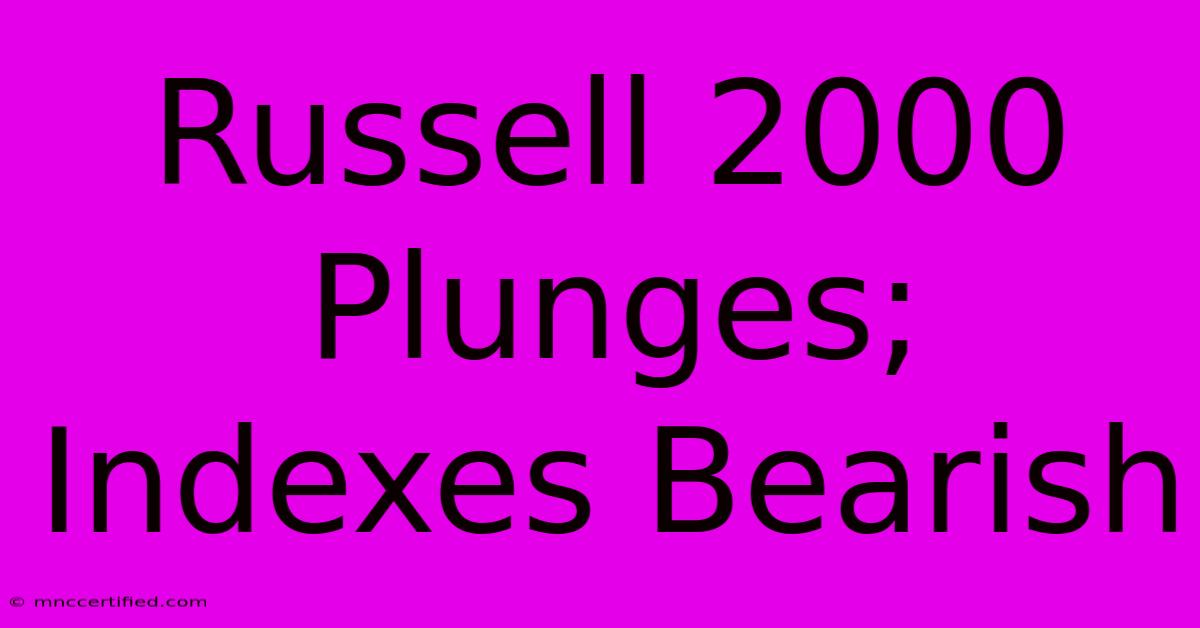Russell 2000 Plunges; Indexes Bearish

Table of Contents
Russell 2000 Plunges; Indexes Bearish: What it Means for Investors
The Russell 2000, a widely followed small-cap stock market index, recently experienced a significant plunge, sending ripples through the investment community and fueling concerns about a broader market downturn. This sharp decline, coupled with bearish signals from other major indexes, has left many investors wondering what this means for their portfolios and the overall economic outlook. This article will delve into the causes behind this market volatility, analyze its implications, and offer strategies for navigating this potentially challenging period.
Understanding the Russell 2000's Recent Plunge
The Russell 2000's dramatic drop reflects a confluence of factors impacting the small-cap sector specifically, and the broader market more generally. These include:
Rising Interest Rates and Inflation: A Double Whammy
The Federal Reserve's ongoing efforts to combat inflation through interest rate hikes significantly impact small-cap companies. These companies often rely more heavily on debt financing, making them particularly vulnerable to rising borrowing costs. Higher interest rates increase their debt servicing burden, squeezing profitability and impacting their stock valuations. Furthermore, persistent inflation erodes consumer spending power, potentially reducing demand for the goods and services offered by many small-cap companies.
Economic Uncertainty and Recession Fears
Growing concerns about a potential economic recession further exacerbate the situation. Small-cap companies are generally more sensitive to economic downturns than their large-cap counterparts. Their smaller size and often more limited financial resources make them less resilient to economic shocks. A recessionary environment could lead to reduced consumer spending, impacting their revenue streams and potentially triggering widespread bankruptcies within the sector. This fear is reflected in the broader market's bearish sentiment.
Geopolitical Instability and Supply Chain Disruptions
Ongoing geopolitical tensions and persistent supply chain disruptions contribute to market uncertainty. These factors add to inflationary pressures and increase the costs of doing business for all companies, but small-cap companies, with their typically leaner operations, often feel the pinch more acutely.
What the Bearish Indexes Mean for Investors
The bearish trend observed not only in the Russell 2000 but also in other major indexes suggests a potential broader market correction. This necessitates a cautious and strategic approach to investing. Here's what investors should consider:
Diversification is Key
Diversification remains crucial in mitigating risk. Investors should ensure their portfolios are spread across various asset classes, including stocks, bonds, and potentially alternative investments. Within the equity market, diversification across different market caps (large-cap, mid-cap, and small-cap) is essential to reduce exposure to any single sector's volatility.
Risk Assessment and Tolerance
A thorough risk assessment is vital. Investors should honestly evaluate their risk tolerance and adjust their portfolio accordingly. Those with a lower risk tolerance may consider shifting towards more conservative investments like bonds or money market funds.
Long-Term Perspective
Maintaining a long-term investment horizon is crucial. Short-term market fluctuations are a normal part of the investment cycle. Panicking and making impulsive decisions based on short-term market movements can be detrimental to long-term investment goals.
Strategies for Navigating Market Volatility
Several strategies can help investors navigate this period of market uncertainty:
Dollar-Cost Averaging
Dollar-cost averaging involves investing a fixed amount of money at regular intervals, regardless of market conditions. This strategy helps mitigate the risk of investing a lump sum at a market peak.
Value Investing
Focusing on value investing – identifying undervalued companies with strong fundamentals – can be a rewarding approach during market downturns. Thorough research and due diligence are essential in this approach.
Rebalancing Your Portfolio
Periodically rebalancing your portfolio to maintain your desired asset allocation can help manage risk and capitalize on market opportunities. This involves selling some assets that have performed well and buying those that have underperformed, bringing your portfolio back to its target allocation.
Conclusion: Staying Informed and Adaptable
The recent plunge in the Russell 2000 and bearish signals from other indexes highlight the importance of staying informed, adapting to changing market conditions, and making well-informed investment decisions. By understanding the underlying factors driving market volatility and implementing appropriate strategies, investors can navigate this challenging period and potentially position themselves for future opportunities. Remember to consult with a qualified financial advisor to tailor a strategy specific to your individual circumstances and risk tolerance. The information provided here is for general knowledge and informational purposes only, and does not constitute financial advice.

Thank you for visiting our website wich cover about Russell 2000 Plunges; Indexes Bearish. We hope the information provided has been useful to you. Feel free to contact us if you have any questions or need further assistance. See you next time and dont miss to bookmark.
Featured Posts
-
Gaetz Funds Sent To Girlfriends
Dec 19, 2024
-
Wright Retires Names Luke In Statement
Dec 19, 2024
-
Stock Market Dips Fed Hints At Rate Slowdown
Dec 19, 2024
-
Us First Severe H5 N1 Bird Flu Case
Dec 19, 2024
-
58 000 Homes Without Water Southampton Outage
Dec 19, 2024